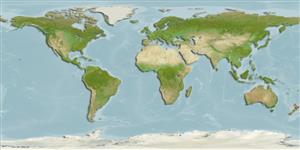>
Gobiesociformes (Clingfishes) >
Gobiesocidae (Clingfishes and singleslits) > Haplocylicinae
Etymology: Gastrocyathus: Greek, gaster = stomach + Greek, kyathos, -ou = hollow of the hand (Ref. 45335).
More on author: Briggs.
Environment: milieu / climate zone / depth range / distribution range
Ecologia
marino demersale; distribuzione batimetrica 0 - 7 m (Ref. 9003). Temperate
Southwest Pacific: endemic to New Zealand.
Size / Peso / Age
Maturity: Lm ? range ? - ? cm
Max length : 4.5 cm TL maschio/sesso non determinato; (Ref. 9003); Età massima riportata: 4 anni (Ref. 9003)
Short description
Morfologia | Morfometria
Spine dorsali (totale): 0; Raggi dorsali molli (totale): 5-6; Spine anali 0; Raggi anali molli: 5 - 7. Uniform red brown to yellowish with variable narrow bands along the head, level with the eye on the dorsal surface of the body, often breaking up into spots on the sides. Fins transparent. Distinguished from other clingfishes by its small size with a slender body tapering behind the head and the pointed fleshy tip on the upper jaw that overhangs the lower jaw.
Found amongst weed at low tide, and on brown algae in the subtidal zone. Appears to be restricted to algal species with strap-like fronds. Feeds mainly on harpacticoid copepods.
Life cycle and mating behavior
Maturità | Riproduzione | Deposizione | Uova | Fecundity | Larve
Paulin, C. and C. Roberts, 1992. The rockpool fishes of New Zealand (Te ika aaria o Aotearoa). Museum of New Zealand (Te Papa Tongarewa). 177 p. (Ref. 9003)
IUCN Red List Status (Ref. 130435)
Threat to humans
Harmless
Human uses
Informazioni ulteriori
Age/SizeAccrescimentoLength-weightLength-lengthLength-frequenciesMorfometriaMorfologiaLarveDinamica popolazioni larvaliReclutamentoAbbondanzaBRUVS
BibliografiaAcquacolturaProfilo di acquacolturaVarietàGeneticaElectrophoresesEreditarietàMalattieElaborazioneNutrientsMass conversion
CollaboratoriImmaginiStamps, Coins Misc.SuoniCiguateraVelocitàModalità di nuotoArea branchialeOtolithsCervelliVista
Strumenti
Special reports
Download XML
Fonti Internet
Estimates based on models
Preferred temperature (Ref.
123201): 13.9 - 17.8, mean 15.9 °C (based on 67 cells).
Phylogenetic diversity index (Ref.
82804): PD
50 = 1.0000 [Uniqueness, from 0.5 = low to 2.0 = high].
Bayesian length-weight: a=0.00398 (0.00191 - 0.00831), b=3.13 (2.94 - 3.32), in cm total length, based on LWR estimates for this species & (Sub)family-body (Ref.
93245).
Trophic level (Ref.
69278): 3.0 ±0.00 se; based on food items.
Resilienza (Ref.
120179): Medio, tempo minimo di raddoppiamento della popolazione 1.4 - 4.4 anni (tmax=4).
Fishing Vulnerability (Ref.
59153): Low vulnerability (10 of 100).
